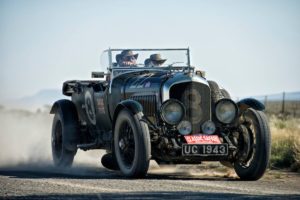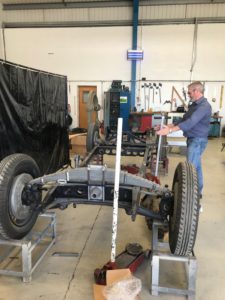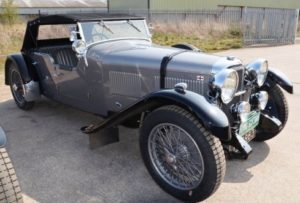In which Sid Bonkers tries to remember why we chose to have an Alvis built for long distance rallies and Epic Journeys.
In the last few years Doris and Sid have enjoyed long distance rallies for old cars organised by the likes of the Endurance Rally Association, Rally the Globe and the Dutch team at Classic Events. In 2012 Dave Gough and Sid bullied and cajoled a recalcitrant Peugeot 504 from London to Cape Town. Doris and Sid have taken Teal the Mini and Sven the Group 2 Kadett Coupe to the sands of the Sahara and the snow and ice of Austria. The people in the old cars always seem to be having a lot of fun and on some events they can win outright.
So how old do cars on these events have to be? Some events have cars up to 1985; is the Porsche 924 really an old car? Perhaps it depends how old you are. 1976 is a more usual cut off, think Datsun 240Z, Escort and 911s various and of course the occasional Mini. So what about the other end of the age range?
 Usually there’s a class for pre-war cars, and they don’t mean Iraq. There are often a few Bentleys like Keith and Norah’s from 1927. Bentleys were described by Ettore Bugatti as “the world’s fastest lorries” for their sturdy durability. Roads then were rougher and cars had to be tough. We also see Lagondas (where W.O. Bentley went to work when he left Rolls Royce). We don’t see a lot of Bugattis.
Usually there’s a class for pre-war cars, and they don’t mean Iraq. There are often a few Bentleys like Keith and Norah’s from 1927. Bentleys were described by Ettore Bugatti as “the world’s fastest lorries” for their sturdy durability. Roads then were rougher and cars had to be tough. We also see Lagondas (where W.O. Bentley went to work when he left Rolls Royce). We don’t see a lot of Bugattis.
While the car might have been invented in Europe the big numbers were produced in America and as early as 1929 about 60% of families had a car, probably a Ford. The US had not yet built its highway system so here too the cars were built for country roads. See Tim Moore’s Another Fine Mess…
On the Peking to Paris which favours sturdy over nimble, American cars have done very well and Rally Preparation Services has made a business building 1930s Chevrolet Fangio Coupes. While we were thinking about having an older car we were lucky enough to drive Joe Robillard’s Big Yellow Coupe from the Cotswolds to Herefordshire and back to RPS. It is very large for European roads and feels like driving a heavy, though torquey, bouncy castle. Very good on a Safari but probably a bit of a liability on a twisty Alpine Trial.
The car for Sid and Doris must be easy to drive, reliable, robust but not too heavy, have good smooth torque to weight, have brakes, be pretty and not cost £500,000. A pre-war BMW 328 would meet all but the last of those, having a six cylinder engine, synchromesh gears and hydraulic brakes.
With no very definite plan we visited Earley Engineering who built this Alvis Special. It has done the Cape Rally in Argentina, the Tiger Rally in Malaysia and a Paris Madrid event all with good reliability. Alex Simpson took us around the shop. We were very impressed with the engineering, what they were working on and their ability to do so much in house. We looked through the stock for ideas and drove a customer’s Speed 25C vairy carefully. It seemed to meet the criteria, and we liked and trusted Alex right away.

Alvis built cars in Coventry from 1921 until 1967, by which time they were mainly working on armoured vehicles for Her Majesty. In 1921 a modified 10/30 lapped Brooklands at 93 mph, it was a sporting marque in the making.
We skip lightly over ten years of development which Wiki can tell you all about. (Please give money to Wiki.) In 1932 Alvis launched the Speed 20 SA with a 2.5 litre six cylinder engine and the chassis were given sporty open bodies by Vanden Plas and Charlesworth.
In 1933 the Alvis Crested Eagle was launched with independent front suspension and a four speed, synchromesh gearbox both of which were fitted to all the bigger models until the war. We will have the benefit of both of these. In 1934 the production chassis was stiffened. Our chassis will be both shortened and stiffened. As the 1930s went on the cars became bigger and the 1935 SD had a wider scuttle to allow wider motorists. Were the plutocrats really bloated? (As an aside compare a current VW Polo with an original Golf…)
As the Speed 20 cars grew so did the engines going from 2,511 cc to 2,762 cc, then 3,571 cc and finally in 1936 to 4,387 cc so even with a saloon body these were 100 mph cars as standard. in 1939 a modified 4.3 litre lapped Brooklands at 115 mph. (That is not something we can do now, but we can and will take the car to Millbrook Proving Ground on the big oval.) In 1938 the next step for that engine was dry sumping for use in tanks. I think we are not going with the dry sump, but we might expect some healthy torque. Naturally Sid will be at the rolling road session to report the early numbers.
To improve the power to weight ratio and handling, Earley are having an alloy block poured. 

A lot of our car will date from 1937 or be as period, but not all. We will have electronic points, an alternator and possibly an electric fan which you can see in the picture above. The body work will be on a metal frame. Ash is nice but does not take well to rattling rough roads.
 The last time we saw the project it required quite a lot of hand-waving to visualise what the end result woud be.
The last time we saw the project it required quite a lot of hand-waving to visualise what the end result woud be.
 Apparently the build is coming along quite well but with lock-down we have not seen it for some months. Eventually it might look rather like this but with wider front wings and a spare wheel mounted on both sides of the bonnet.
Apparently the build is coming along quite well but with lock-down we have not seen it for some months. Eventually it might look rather like this but with wider front wings and a spare wheel mounted on both sides of the bonnet.
As soon as we can sneak down to Herefordshire we will tell you all about how it is coming along.